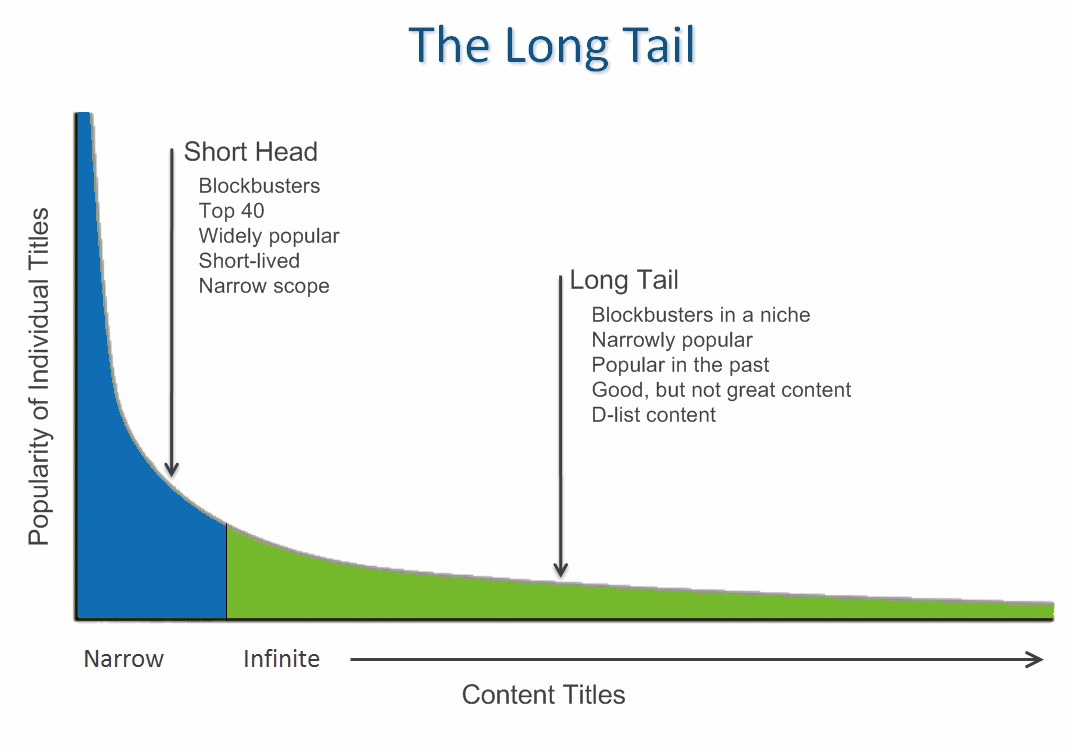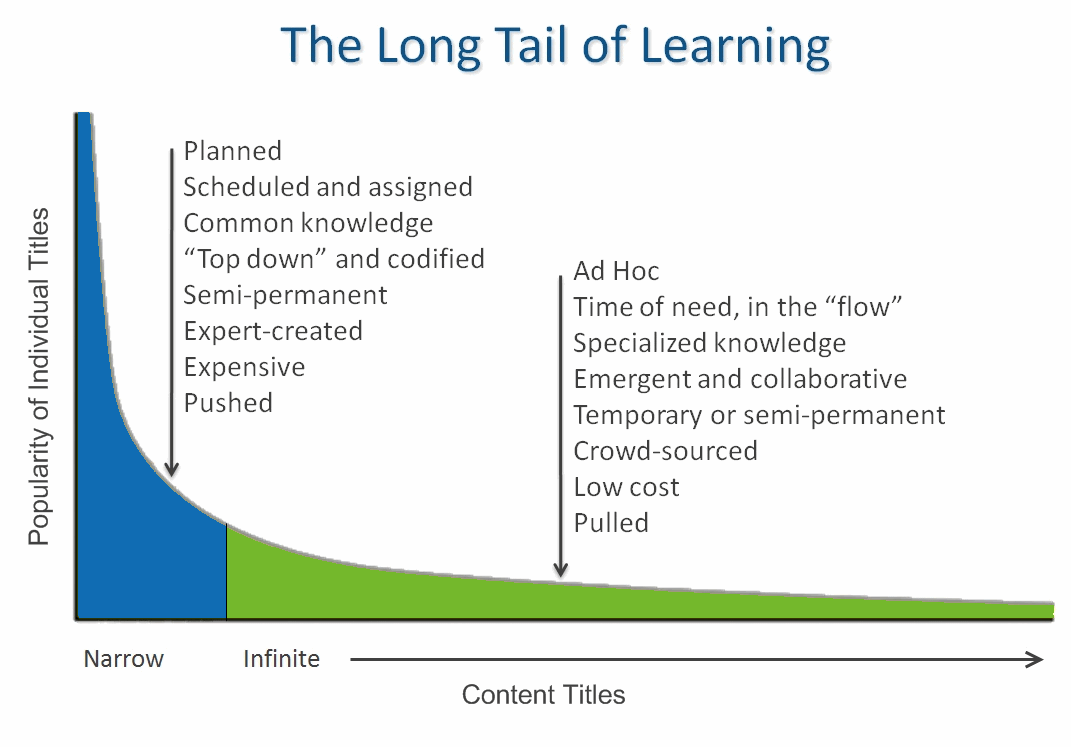A few years ago, I read a book that changed my thinking across several subjects including economics, personal choice, networks, and popularity. More recently, it’s also changed my thinking about the way we conduct, deliver, and manage corporate learning. More on that in a bit…
The book was The Long Tail: Why the Future of Business is Selling Less of More, by Chris Anderson. I read it at the request of a colleague and devoured it cover-to-cover during one long plane ride from Boston to San Francisco. I couldn’t put it down.
The Long Tail covers a lot of ground, but the main argument is that traditional economic models, the ones predicated on concepts of scarcity and physical goods, don’t do a great job of explaining the economics of digital assets. An example of a physical goods market is the music section in your local Walmart. There is a limited amount of physical space available to stock CD’s. To make a profit, those CD’s need to sell a certain number of copies each month. It’s a classic supply and demand economic scenario.
The short and the long of retailing
So how does Walmart decide which CDs to stock? It’s simple really; they just sell the biggest hits in the broadest music genres: Pop, Rock, Country, Jazz. You aren’t going to find many Punk Rock or Afro-Cuban Jazz albums at your local Walmart. In fact, 99% of the albums on the market today aren’t sold at your local Walmart.
On the other hand, you will find over 65 Afro-Cuban Jazz albums on iTunes. And a whole lot of everything else too. Unlike Walmart and physical retailers, electronic retailers like iTunes, Netflix, and Amazon sell digital assets. They have unlimited shelf-space. They can “stock” as much as Afro-Cuban Jazz as they want. More importantly, research shows that it will sell.
In every year since iTunes began, they have sold at least one copy of every single title they offer. Moreover, these one or two unit sales across millions of “less popular” items add up to millions and millions of sales. A quarter of Amazon’s book sales come from outside its top 100,000 titles. By contrast, the same top 100,000 titles are the full extent of the sales offering at your local Borders bookstore. It’s the Walmart music section on a broader scale – a larger set of offerings, but still heavily dependent on physical space and high sales per item.
Borders and Walmart are selling what’s known as the “short head” – the most popular, blockbuster sort of titles. Amazon sells the “short head” too, but they also sell the “long tail” – the millions of less popular titles that might only sell a few copies a year. Through recommendation engines, ratings, reviews, and various other filtering techniques, shopping portals like Amazon, iTunes, and Netflix enable buyers to find and pursue content deep into the overall collection. For the first time, non-hits and niche content can be found as easily as summer blockbusters and the weekly top 40. If you’re new to the idea of the long tail, Figure 1 is the classic, generic illustration.

Figure 1 The generic Long Tail
Implications for learning
So what does all of this have to do with learning? Quite a bit actually. As learning professionals, we have our own economics of shelf space, “sales per item,” and scarcity. Our “shelf space” isn’t limited by physical space, but by time, the time available that learners can dedicate to training in a given week. Think of the shelf as a 40-hour workweek. Most of the shelf is filled with work-related tasks, the individual production of each employee that contributes to the overall success of the organization. Within this larger shelf of hours, a relatively small percentage is dedicated to training and development. It might be just five to ten percent of the overall shelf space.
Given the limited shelf space we have available, what do we offer to our buyers, Afro-Cuban Jazz or the Top 40? Think about it. We offer the Top 40, the hits, and the summer blockbusters. In the world of training, these are compliance, certification, and curriculum – the content that the greatest majority of learners must know. Even when we buy large libraries of off-the-shelf content, the libraries themselves are filled with the “hits” – OSHA compliance, Word, PowerPoint, Excel, Leadership Development, and so on.
There is nothing wrong with any of this. In fact, given the economics of the situation, this is exactly what we should offer – knowingly or not, we are following tried-and-true economic models. We are also limited by our own resource scarcity. Some training departments struggle even to deliver the Top 40. Throw in a few high-priority initiatives like a major application roll-out, a new product offering, or a change in corporate direction, and the typical training organization thinks immediately about outsourcing to one of thousands of custom-content training companies that exist for just this reason.
Creating a learning long tail
So now that we know what we are, the next question is, “What do we want to be?” First, ask yourself if, in your current model, you are satisfying all of the learning demands of your buyers. Most research shows that people acquire 80% of the skills and knowledge they use on the job outside of formal learning. Clearly our buyers do have other interests and demands. Today, they are satisfying them outside of our formal channels through peer-to-peer exchange, e-mail, one-off phone calls, water cooler conversation, and time-of-need mentoring. In other words, when they can’t find what they want in the “short head” offerings from their training department, they source their needs through the “long tail” expertise that exists in the information cloud of their extended network. They leave Walmart and buy from Amazon.
In other words, our learners are already living in the Learning Long Tail; the problem is that we are not. Learning is happening as a black market knowledge exchange over which we exert no influence, let alone control. We can’t report on it. We don’t even know who is participating and what they are discussing. We don’t know whether the information is accurate. Worse, other learners are unable to leverage the time learners spend finding and sharing good information. Nearly all of the exchanges happen as one-off’s that are not captured or shared with any other learners.
Fortunately, the solution to all of these issues – the formalizing of learners’ informal exchanges – also provides a mechanism for increasing our shelf space, decreasing our costs for production, turning our content creation scarcity into abundance, and providing methods of oversight and approval for sensitive topics. What does it mean to formalize learners’ informal exchanges?
- Provide learners with the tools to share their own expertise: course creation, virtual classroom, discussions, chat, blogs, and customizable social profiles at a minimum.
- Provide learners with a place to share their assets: file exchanges, course uploads, publishing of virtual classroom schedules, shared spaces where they can chat, discuss, and blog about specific topics and interest areas.
- Enable robust reporting on producers, consumers, and “hot” topics. Who is creating? What is being created? And who is consuming it? What are the trends?
- In addition to deep search, also include filtering technology like ratings, reviews, comments, and recommendation engines to help learners go deep into your content stack.
- Routing technology and processes to ensure that sensitive topics are reviewed and approved before being submitted, and inaccurate material is flagged and removed before it can cause any damage.
- Notification and subscription mechanisms to automatically alert learners to new updates, replies, and edits to topics of interest.
Benefits of a Long Tail for learning
Approaches like those noted above help us move a lot closer to an Amazon or iTunes model. They ensure, first and foremost, that the content we’re all sharing is accurate and approved, particularly for sensitive subjects. They also enable us to increase our shelf space, not by adding more hours to the week, but by decreasing the length and changing the nature of the content. Participating in a discussion about work is a very different experience than taking a two-hour long course on the same subject. The former is collaborating as “part of” a learner’s work; the latter is “taking training” about the work. The shelf space for the first activity is the learner’s entire work week; the latter is still bound by limitations on training interventions.
The costs of production in this model also change. The size of the training organization is the size of the company itself, maybe even the extended enterprise if you are willing to include partners, suppliers, and resellers. The costs of production are therefore spread across the collective contributors rather than just one central pool of instructional design experts. This also means that the challenge of resource scarcity in creating content is replaced with resource abundance, both in terms of content producers and in terms of the content itself.
Just as in the Long Tail of economics, the Long Tail of Learning is a theory of abundance, where learners have more opportunities to learn and teachers have more opportunity to teach. It's a world where everyone is both a teacher and a learner, where the content is as varied as the work and as deep as the need. It's a world where the work is the learning and the learning is the work, and where traditional notions of training budgets and employee development time are augmented by flatter, more open models.
Does this mean certification, compliance, and curricula go away? No, of course not. Even with iTunes and Netflix and Comcast OnDemand, there are still hit shows, Top 40 music, and blockbuster movies. As we begin providing formal support and infrastructure to support our organization’s learning long tail, we still need to create, manage, and deliver the “short head.” What might this combined model look like? (see diagram for the Long Tail of Learning)

Figure 2 The Long Tail of learning
The shift here lies in recognizing that every organization has a short head and a long tail. In formal, heavily regulated industries, more focus may need to be paid to the short head. In consulting or technology companies, perhaps more focus should be placed on the long tail. The Long Tail theory provides a model to think through these strategies, helping you to focus resources and development dollars in ways that deliver the most value and impact to your organization.
Reference
Anderson, Chris. (2006). The Long Tail: Why the Future of Business is Selling Less of More. New York. Hyperion.



